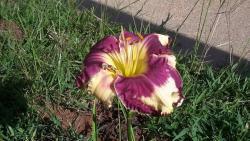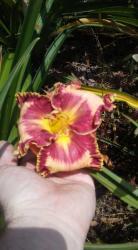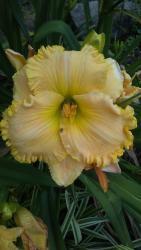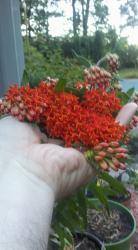@clockworkhawkins
"how can a triploid even create a gamete how many pairs does it create?"
In a diploid the chromosome pairs can align without problems as they each have only one partner.
In a triploid the chromosomes can align as triplets or pairs with singles. Each of the 11 sets of chromosomes in a diploid can align independently from all others. The end result is that the gametes have a wide range of chromosome numbers in a triploid. However not all chromosome counts in a gamete are viable. So the range of chromosome numbers in viable gametes produced by a triploid are much narrower. The normal chromosome count for a diploid gamete (eg pollen) is 11, the normal count for a tetraploid is 22 but a triploid might produce gametes with 18, 19, 20, 21, 22, 23, 24, 25, 26, 27, 28, etc. chromosome counts. Most gametes produced by a triploid are not viable. Most embryos produced by crosses involving triploids are not viable or the endosperm (nutrient tissue in the seed) is not viable or both. So most triploids in most species are considered to be sterile. In some cases, with enough crosses one may get lucky and have a viable seed(s). Arisumi tended to find that triploids were more fertile with tetraploids than they were with diploids.
No one has checked the chromosomes of 'Implausibility'. There is at least one known triploid (chromosomes counted) that is quite fertile with tetraploids. It is plausible that 'Implausibility' is simply another triploid (or other type of aneuploidy). There is more than one plausible explanation for the fertility of Implausibility with tetraploids. Aneuploids have unbalanced chromosome counts. So a diploid daylily should have 22 chromosomes (11 pairs - two of each set). An aneuploid may have 20 or 21 or 23 or 24, etc. chromosomes (only one chromosome of some sets or three chromosomes of some sets, etc.).
A triploid would (normally) extremely rarely produce an "unreduced gamete" (unreduced does not really apply to the triploid gametes - 2n gamete is the better term) of 22 balanced chromosomes. Whatever frequency it produced such gametes should be equal to the frequency at which it produced balanced gametes of 11 chromosomes and therefore be capable of producing diploid seedlings when crossed with a diploid. That probability might be estimated from the number of crosses Stout made with 'Europa' and the number of viable seedlings he produced. However that assumes that each one of those seedlings had 22 balanced chromosomes and that is unlikely.
Arisumi did not check 'Ed Murray'.
fulva 'Korean' has been claimed to produce 2n gametes. There are difficulties with that idea.
"Ploidy variation and karyotype analysis in Hemerocallis spp. (Xanthorrhoeaceae) and implications on daylily breeding"
This research has unknown problems that resulted in the researchers "finding" that a number of cultivars have a different ploidy from that registered or from that determined by other researchers. I consider their findings unreliable.
However, it is known that triploid daylilies exist naturally. Triploid plants can be created naturally by somatic chromosome doubling. It is not known (as far as I know but I have not done a literature search) what proportion of natural triploids were created by somatic doubling (or any other method) in comparison to unreduced (2n) gametes.
Colchicine changes the chromosome number. Almost by definition that may result in cancer if it sometimes produces some cells with unbalanced chromosome counts. It also causes other changes and probably also causes mutations of other sorts. However, it is apparently still used medicinally.






















